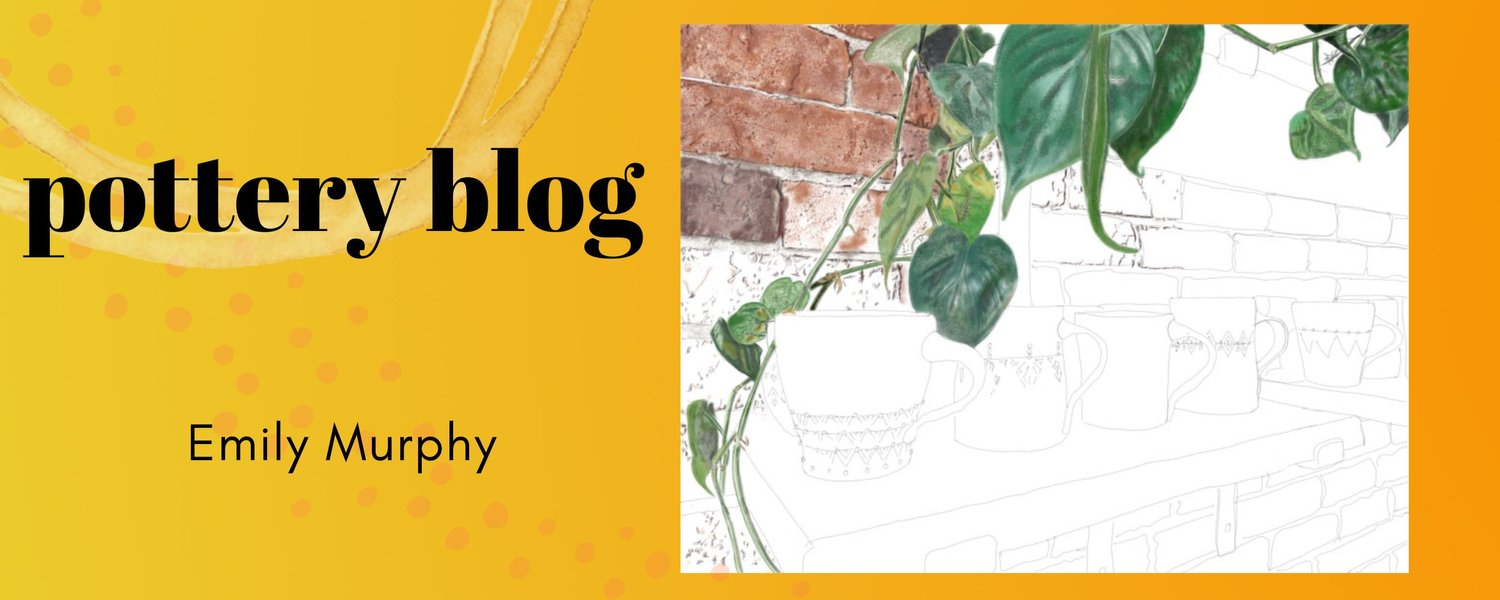What is soda firing?
This post is part of a handout that I give to my soda firing students at Lillstreet Art Center. It is an attempt to explain a little bit about the history of soda firing, and tries to help answer the question, "what is soda firing?". It is not the full story, but I hope that you find it helpful.
 Soda firing is an atmospheric firing technique where “soda is introduced into the kiln near top temperature (2350°, ∆10). The soda that we use is: sodium bi-carbonate, also know as baking soda (the Arm and Hammerâ„¢ kind), and sodium carbonate, which is also known as soda ash.
Soda firing is an atmospheric firing technique where “soda is introduced into the kiln near top temperature (2350°, ∆10). The soda that we use is: sodium bi-carbonate, also know as baking soda (the Arm and Hammerâ„¢ kind), and sodium carbonate, which is also known as soda ash.
“Soda ash is the trade name for sodium carbonate, a chemical refined from the mineral trona or sodium-carbonate-bearing brines (both referred to as "natural soda ash") or manufactured from one of several chemical processes (referred to as "synthetic soda ash"). It is an essential raw material in glass, chemicals, detergents, and other important industrial products.
– USGS
The soda vaporizes and is carried on the flame throughout the kiln. The soda vapors create a glaze when it lands on a piece (or a kiln post, or the wall of the kiln). Wherever the flame travels- so does the soda. When placing the pieces in the kiln during loading, you have to think carefully about when and where you want a piece to get lots of soda, or when and where you want a piece to be more protected. The kiln must be evenly loaded because the flame will travel on the path of least resistance (and therefore the soda will also be traveling on the path of least resistance). You also have to think about whether or not the piece is glazed. The soda is basically a glaze, and when two glazes mix, they can react chemically with one another and run down the side of the piece. It's beautiful when you can control the run- but can be disastrous when it gets away from you!
What is the history of soda? Where did it come from?
The predecessor of the modern day soda firing, is salt firing. It is believed that salt firing began in Germany in the 13th century. As many things go, it was most likely come upon by accident. Perhaps some salt soaked wood (from pickling barrels?) was tossed into the kiln for the wood fuel. The salt vaporized and glazed the pieces inside the kiln. It was a great time saving measure. No need to glaze the pieces before they went into the kiln. Old German jugs were salt glazed, along with tankards and sewer pipes. The pieces that we think of as early American traditional ceramics from the southwest corner of the US were also salt glazed. Can you picture a big whiskey jug with cobalt blue decoration on it? Those were salt fired. The process that I'm talking about is wood firing with salt thrown in. The salt easily glosses up a piece and helps the wood ash flux out. Salt vaporizes at a fairly low temperature and can work its way into all sorts of nooks and crannies. In a salt firing, the salt vaporizes and the sodium chloride splits into sodium and chlorine gas. When the chlorine is exposed to moisture, it forms hydrochloric acid. The acid goes into the kiln atmosphere and is released from the chimney. The remaining sodium combines with alumina and silica in the clay to forming a glaze on the surface of the piece.
Although the previous paragraph doesn't help sort out what soda firing is, it does give some important background information. Salt firing continued to be a technique used by potters up through the 1970's (and is still is used as a firing method today). In the 70's as people became more aware of the environment, they realized that the black smoke and hydrochloric acid wasn't such a great idea. A couple of graduate students from Alfred University, NY studied sodium alternatives to salt firings, hoping to find something that was more environmentally friendly, and maybe even something that could happen in an urban environment.
The results were soda ash and baking soda. They produce carbon dioxide instead of hydrochloric acid. The soda doesn't get into all the nooks and crannies like the salt does, but it does produce brighter and more vivid colors. Pots are usually glazed with an interior or “liner glaze because the soda vapors won't work their way into those hard to reach places. You can achieve a rich glossy surface that is heavy with soda, or a pebbled surface that is also referred to as an “orange peel texture. This is often juxtaposed with a “drier area of the clay that wasn't hit directly with the soda. It's all of these varied surfaces together that make up the rich look and feel of a soda fired pot. 30 years ago, when soda firing first began, most ceramicists were just trying to mimic the effects of salt firing. In the last 5 years that has changed. The true characteristics of soda firing are unique and are something to explore and achieve.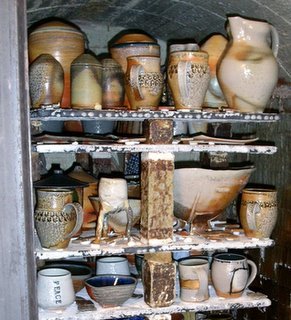
The soda vapors aren't actually colored, but they are reacting with the alumina, silica and iron in the clay (and slips) to create the various colors of flashing, and associated textures. The resulting colors can be a range of oranges with yellow and red tones, to rich browns, golds and tans. If there is some copper in the kiln, there can be pink blushing. Or a cobalt glaze on a piece can cause a blue twinge to the soda. Sometimes the carbon from the firing can add a gray hue that can look like shark skin on porcelain.
So perhaps now you know a little bit more about soda firing.
I've included the recipe that I use for my soda firings below.
My soda recipe: (a variation on Gail Nichol's process)
2 lbs. soda ash
3.5 lbs. sodium bi-carb
5.5 lbs. whiting (calcium carbonate)
Mixed with ½ of a 5 gal. bucket of wood chips, and water
*mix the dry stuff with the wood chips, and then add COLD water. Just enough so it sticks together. It should have a consistancy similar to oatmeal cookie dough or tunafish salad.
-Add soda into kiln when ∆9 is soft. Add 1 ½ angle irons full of soda mixture through each port. Wait 15 minutes between additions. Usually takes 3 turns to add in all of the soda.

“Soda ash is the trade name for sodium carbonate, a chemical refined from the mineral trona or sodium-carbonate-bearing brines (both referred to as "natural soda ash") or manufactured from one of several chemical processes (referred to as "synthetic soda ash"). It is an essential raw material in glass, chemicals, detergents, and other important industrial products.
– USGS
The soda vaporizes and is carried on the flame throughout the kiln. The soda vapors create a glaze when it lands on a piece (or a kiln post, or the wall of the kiln). Wherever the flame travels- so does the soda. When placing the pieces in the kiln during loading, you have to think carefully about when and where you want a piece to get lots of soda, or when and where you want a piece to be more protected. The kiln must be evenly loaded because the flame will travel on the path of least resistance (and therefore the soda will also be traveling on the path of least resistance). You also have to think about whether or not the piece is glazed. The soda is basically a glaze, and when two glazes mix, they can react chemically with one another and run down the side of the piece. It's beautiful when you can control the run- but can be disastrous when it gets away from you!
What is the history of soda? Where did it come from?
The predecessor of the modern day soda firing, is salt firing. It is believed that salt firing began in Germany in the 13th century. As many things go, it was most likely come upon by accident. Perhaps some salt soaked wood (from pickling barrels?) was tossed into the kiln for the wood fuel. The salt vaporized and glazed the pieces inside the kiln. It was a great time saving measure. No need to glaze the pieces before they went into the kiln. Old German jugs were salt glazed, along with tankards and sewer pipes. The pieces that we think of as early American traditional ceramics from the southwest corner of the US were also salt glazed. Can you picture a big whiskey jug with cobalt blue decoration on it? Those were salt fired. The process that I'm talking about is wood firing with salt thrown in. The salt easily glosses up a piece and helps the wood ash flux out. Salt vaporizes at a fairly low temperature and can work its way into all sorts of nooks and crannies. In a salt firing, the salt vaporizes and the sodium chloride splits into sodium and chlorine gas. When the chlorine is exposed to moisture, it forms hydrochloric acid. The acid goes into the kiln atmosphere and is released from the chimney. The remaining sodium combines with alumina and silica in the clay to forming a glaze on the surface of the piece.
Although the previous paragraph doesn't help sort out what soda firing is, it does give some important background information. Salt firing continued to be a technique used by potters up through the 1970's (and is still is used as a firing method today). In the 70's as people became more aware of the environment, they realized that the black smoke and hydrochloric acid wasn't such a great idea. A couple of graduate students from Alfred University, NY studied sodium alternatives to salt firings, hoping to find something that was more environmentally friendly, and maybe even something that could happen in an urban environment.
The results were soda ash and baking soda. They produce carbon dioxide instead of hydrochloric acid. The soda doesn't get into all the nooks and crannies like the salt does, but it does produce brighter and more vivid colors. Pots are usually glazed with an interior or “liner glaze because the soda vapors won't work their way into those hard to reach places. You can achieve a rich glossy surface that is heavy with soda, or a pebbled surface that is also referred to as an “orange peel texture. This is often juxtaposed with a “drier area of the clay that wasn't hit directly with the soda. It's all of these varied surfaces together that make up the rich look and feel of a soda fired pot. 30 years ago, when soda firing first began, most ceramicists were just trying to mimic the effects of salt firing. In the last 5 years that has changed. The true characteristics of soda firing are unique and are something to explore and achieve.

The soda vapors aren't actually colored, but they are reacting with the alumina, silica and iron in the clay (and slips) to create the various colors of flashing, and associated textures. The resulting colors can be a range of oranges with yellow and red tones, to rich browns, golds and tans. If there is some copper in the kiln, there can be pink blushing. Or a cobalt glaze on a piece can cause a blue twinge to the soda. Sometimes the carbon from the firing can add a gray hue that can look like shark skin on porcelain.
So perhaps now you know a little bit more about soda firing.
I've included the recipe that I use for my soda firings below.
My soda recipe: (a variation on Gail Nichol's process)
2 lbs. soda ash
3.5 lbs. sodium bi-carb
5.5 lbs. whiting (calcium carbonate)
Mixed with ½ of a 5 gal. bucket of wood chips, and water
*mix the dry stuff with the wood chips, and then add COLD water. Just enough so it sticks together. It should have a consistancy similar to oatmeal cookie dough or tunafish salad.
-Add soda into kiln when ∆9 is soft. Add 1 ½ angle irons full of soda mixture through each port. Wait 15 minutes between additions. Usually takes 3 turns to add in all of the soda.
Lillstreet Studios website
It's finally done (almost). The website that I have been making for the group of artists where I have my studio in Chicago: Lillstreet Studios. If you're not familiar with it, Lillstreet Art Center is a big art center that houses ceramics classrooms, metalsmithing studios, a glass bead making studio and more. Mostthe art center is on the first floor of the building. The 2nd and 3rd floors are what make up Lillstreet Studios. We have over 40 independant artists working. Most are potters, but we also have jewelers, photographer, painters, etc...
We've been putting a lot of energy into working together as a group like doing this website and hosting a montly open house called 2nd Saturdays. (Just what it sounds like- a monthly open house on the 2nd Saturday of each and every month!)
It's great to be a part of a community. There are always people around to brainstorm on business decisions like pricing, or just to have an informal critique about a form. There is a lot of solitary time being a potter (and even more doing all this computer work), but being in this kind of studio helps to balance that out.
Here are a couple of images of some of the studio artists working in their own spaces:
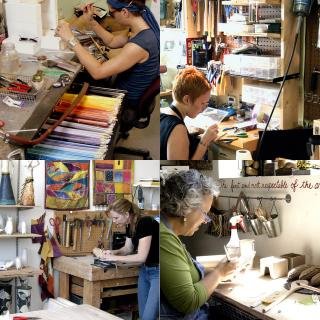 Amy Lemaire, Sarah Busen, Dana Major Kanovitz and Cathi Bouzide are pictured above.
Amy Lemaire, Sarah Busen, Dana Major Kanovitz and Cathi Bouzide are pictured above.
I hope you enjoy wandering through this site.
We've been putting a lot of energy into working together as a group like doing this website and hosting a montly open house called 2nd Saturdays. (Just what it sounds like- a monthly open house on the 2nd Saturday of each and every month!)
It's great to be a part of a community. There are always people around to brainstorm on business decisions like pricing, or just to have an informal critique about a form. There is a lot of solitary time being a potter (and even more doing all this computer work), but being in this kind of studio helps to balance that out.
Here are a couple of images of some of the studio artists working in their own spaces:

I hope you enjoy wandering through this site.
Second Saturdays- Studio Open House
Saturday, July 9, 2005 -11am - 5pm-
The studio artists of Lillstreet Studios in Chicago are having the first "Second Saturday" studio open house/sale.
We're coming upon our 2 year anniversary in Lillstreet's new location in Ravenswood. The second and third floors are filled with a variety of artists from potters, to jewelers , to photographers, and more. We're been wanting to organize some sort of monthly event- and we're finally doing it! I hope you can make it!

The studio artists of Lillstreet Studios in Chicago are having the first "Second Saturday" studio open house/sale.
We're coming upon our 2 year anniversary in Lillstreet's new location in Ravenswood. The second and third floors are filled with a variety of artists from potters, to jewelers , to photographers, and more. We're been wanting to organize some sort of monthly event- and we're finally doing it! I hope you can make it!

Mark of the Flame
Throughout the Spring session at Lillstreet Art Center, my Advanced Topics in Soda Firing class worked on putting together an exhibition of their work- from developing the idea of the show, to producing the work. I'm really excited about the direction this project has taken. The results can be seen at the opening of the exhibition on July 16. Please see below for more information.
The idea of the exhibition is that each set or series of pieces was designed and placed in the kiln to intentionally mark the surface with the pattern and shadow of the flame. All the pieces are fired in the soda kiln, where the soda vapors are being carried with the flame. The results of this are some really exciting pieces that tell the story of how they were made. Photographs of the pieces in the kiln (like the ones seen below) will accompany the displayed ceramics. Please click on image to see it larger-and to read all the details.
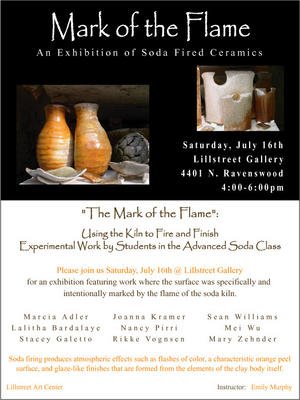
The opening reception is Saturday, July 16th at Lillstreet's Gallery in Chicago. There are several openings happening at the same time- it should be quite an event! If you need directions- please click here.
I hope to see you there!
The idea of the exhibition is that each set or series of pieces was designed and placed in the kiln to intentionally mark the surface with the pattern and shadow of the flame. All the pieces are fired in the soda kiln, where the soda vapors are being carried with the flame. The results of this are some really exciting pieces that tell the story of how they were made. Photographs of the pieces in the kiln (like the ones seen below) will accompany the displayed ceramics. Please click on image to see it larger-and to read all the details.

The opening reception is Saturday, July 16th at Lillstreet's Gallery in Chicago. There are several openings happening at the same time- it should be quite an event! If you need directions- please click here.
I hope to see you there!
Studio Sale - May 7th, 2005

As you can see from my postcard image above, I'm having a studio sale at my studio (an innovative idea...) in Chicago on May 7th from 10am - 5pm. To learn more about this sale and to get important information like directions to the studio and payment options, please head on over to sodafired.com and you'll see all the pertinent information you need right there. I hope you can make it.
A Tour of Blogs about Pottery and Ceramics
One reason why people blog is to participate in their community. For me, it's a way to have a conversation about clay and related topics with a larger clay community. In the more technical world (programmers, etc.. ) bloggers read, link and comment to one another- creating a larger dialog. In the ceramics world, there is less blogging going on. Most potters that I talk to about my blog respond "what's a blog?". Today's post is answering that question, in part, by showing potteryblog.com readers what else is going on out there in the clay blogging world. I think it's just beginning- hopefully I will be able to update this list in the future with many more clay weblogs.
Here is an overview of some clay related blogs- in no particular order. I left out some blogs that haven't been updated in a while, or didn't have much content about pottery. Otherwise, this is a pretty good sampling of what's out there. Please let me know if I'm missing something or if something new comes along. Enjoy the tour!

John Norris: Containers of information: Art, Ceramics, Information, and You.
John has an extensive website that covers lots of topics including clay and conceptual art. He has t-shirts that he has designed for sale...handouts for teaching purposes, and perhaps most exciting: he has a pottery podcast called: Cone 11 Forced Air (a podcast is a regularly produced MP3 in a radio format). Take a listen and enjoy. I'm looking forward to more!

Nathan Pearlman: Political Mammal
Nathan's blog is not actually a blog that is specifically about pottery, but includes a couple of nice articles directly related to clay- the one that is linked above, and a previous one that I linked to in the Soda Fired Mug post.

Mashiko Potter: Things Related to Making Functional Pottery
Beautiful photos of Lee's work- finished and in progress, in Mashiko, Tochigi, Japan.

kasumipottery.com weblog: An authorized weblog of Kasumi Pottery Studio by Rolando
This is an interesting site. It's not written and maintained by the artist, but is about the artist. A different format- kept up to date well.
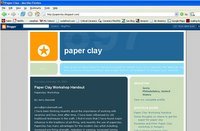
Paper Clay
This is a blog about paper clay (to state the obvious). Not what I'm really interested in at this moment, but the direction of this blog is interesting- a focus on a very specific subject matter.

PBA Pottery Blog - Muddlings
A nice name, and the accompanying site is nice too, but this blog doesn't have too much content related to clay & pottery- despite the name. I'm hoping that there is more to come- check back for more.
___________________________________________________

As I am writing this, I'm listening to NPR. A story on Warren Mackenzie just came on during All Things Considered. You can read the text and view the photos on the linked site, but you should also click on the "listen" button and listen to him in his own words.
Here is an overview of some clay related blogs- in no particular order. I left out some blogs that haven't been updated in a while, or didn't have much content about pottery. Otherwise, this is a pretty good sampling of what's out there. Please let me know if I'm missing something or if something new comes along. Enjoy the tour!

John Norris: Containers of information: Art, Ceramics, Information, and You.
John has an extensive website that covers lots of topics including clay and conceptual art. He has t-shirts that he has designed for sale...handouts for teaching purposes, and perhaps most exciting: he has a pottery podcast called: Cone 11 Forced Air (a podcast is a regularly produced MP3 in a radio format). Take a listen and enjoy. I'm looking forward to more!

Nathan Pearlman: Political Mammal
Nathan's blog is not actually a blog that is specifically about pottery, but includes a couple of nice articles directly related to clay- the one that is linked above, and a previous one that I linked to in the Soda Fired Mug post.

Mashiko Potter: Things Related to Making Functional Pottery
Beautiful photos of Lee's work- finished and in progress, in Mashiko, Tochigi, Japan.

kasumipottery.com weblog: An authorized weblog of Kasumi Pottery Studio by Rolando
This is an interesting site. It's not written and maintained by the artist, but is about the artist. A different format- kept up to date well.

Paper Clay
This is a blog about paper clay (to state the obvious). Not what I'm really interested in at this moment, but the direction of this blog is interesting- a focus on a very specific subject matter.

PBA Pottery Blog - Muddlings
A nice name, and the accompanying site is nice too, but this blog doesn't have too much content related to clay & pottery- despite the name. I'm hoping that there is more to come- check back for more.
___________________________________________________

As I am writing this, I'm listening to NPR. A story on Warren Mackenzie just came on during All Things Considered. You can read the text and view the photos on the linked site, but you should also click on the "listen" button and listen to him in his own words.
A Potter's Mark: Signing Pots
I just got a new stamp with my signature to sign the bottoms of my pots with. I ordered the stamp at NCECA, and it arrived in the mail last week. Todd Scholtz, owner of claystamps.com was set up at the Brackers Good Earth Clay, Inc booth.
He had me sign a piece of paper to get the right signature. I think that I wrote it about 40 times to get the feel and look that is most consistent with how I usually sign my work. The 10th signature ended up being the one that I used.
He then scanned the chosen signature into a computer and resized to my specifications. He then engraved the stamp and added a nice wooden handle. I am really happy with the results. It stamps beautifully- wet, leather hard, and even a little past leather hard all come out clearly and easily. If I want another stamp- smaller or larger, I can have the same signature, just resized. If you have some other sort of mark, it would work as well- whether you have it as a digital image already, or you have Todd scan it in for you.
I've tried to figure out a good signature stamp for years. I don't like the chunkiness of a clay stamp for my signature, and the fragility always worried me. Rubber stamps are easy to have made, but they aren't deep enough or firm enough for stamping the bottom of a trimmed, leather hard piece. This stamp seems to be a good alternative.
Take a look at the results:

The flashing from the soda kiln on the bottom of this plate could not have been any more picture perfect!
I have always felt that it is important for me to sign my work. Here are some thoughts on signing or not signing pots...

I think that this blog entry will be the first of many about signing work. There is much more to talk about. I'd love to hear your ideas about signing or not signing pottery, or what your method is.
If you'd like to sign up for the Pottery Blog mailing list, go here. You'll get automatic emails when I write and post a new entry. As always, it is a private mailing list- no information will ever be shared!
He had me sign a piece of paper to get the right signature. I think that I wrote it about 40 times to get the feel and look that is most consistent with how I usually sign my work. The 10th signature ended up being the one that I used.
He then scanned the chosen signature into a computer and resized to my specifications. He then engraved the stamp and added a nice wooden handle. I am really happy with the results. It stamps beautifully- wet, leather hard, and even a little past leather hard all come out clearly and easily. If I want another stamp- smaller or larger, I can have the same signature, just resized. If you have some other sort of mark, it would work as well- whether you have it as a digital image already, or you have Todd scan it in for you.
I've tried to figure out a good signature stamp for years. I don't like the chunkiness of a clay stamp for my signature, and the fragility always worried me. Rubber stamps are easy to have made, but they aren't deep enough or firm enough for stamping the bottom of a trimmed, leather hard piece. This stamp seems to be a good alternative.
Take a look at the results:

The flashing from the soda kiln on the bottom of this plate could not have been any more picture perfect!
I have always felt that it is important for me to sign my work. Here are some thoughts on signing or not signing pots...
- It is an historical record of the maker. There are lots of books about the marks on old pots. I'm not saying that my mark is going to end up in a book, but the idea of being able to figure out who made a pot, a print or a painting is still interesting to me. Having a clear and identifiable signature would make that much easier.
- I own several pots by different potters that aren't signed (or it's hard to make out). When I bought them, I remembered clearly who made them, but as time has passed, some of those names have left me. If I wanted more work by the same artist, I'd sort of have to wait to come upon it again at a gallery.
- Ceramics Monthly has started including the stamp or mark of each of the ceramic artists that are featured in their magazine. This seems to be some sort of recognition of the importance of the stamp even in contemporary ceramics (as opposed to the historical documentation that I talked about above).
- The Potter's Council is asking for potter's to send in their marks to create an archive of stamps and signatures. They can be sent to: Jennifer Poellet, 735 Ceramic Place, Suite 100, Westerville, OH, 43081.
- Over time my signature or stamp have changed and evolved. All clearly are by the same maker, but it is a way that I can sort of "date" my pieces, without actually recording a date on them.
- I come from a family of artists, and the bold signature of MURPHY is something of a common occurrence on our work. Here is my dad's signature (Jim Murphy) from one of his paintings:

I think that this blog entry will be the first of many about signing work. There is much more to talk about. I'd love to hear your ideas about signing or not signing pottery, or what your method is.
If you'd like to sign up for the Pottery Blog mailing list, go here. You'll get automatic emails when I write and post a new entry. As always, it is a private mailing list- no information will ever be shared!
Sodafired.com Update
As you probably know, I have these two websites- the one that you're reading, potteryblog.com, and my main one for my ceramic pots, sodafired.com. My hope is that visitors of both go back and forth between the two without necessarily realizing that they have technically gone to a different site. They each serve their own purpose, but those purposes overlap one another.
I just started a sort of "mini-blog" on sodafired.com. I will use it as a way to share studio announcements and that sort of information. It's little news box on the front page of my site.
Tonight the first entry is posted. Just go *here* to read it. I will update it several times a month- or as often as necessary. In the almost 6 years that I have maintained a website of my pottery, I have tried to figure out a good way to fulfill these objectives:
1. Notify people of sales, shows and new work.
2. Make it obvious that the website is really up-to-date and, in general, make it obvious that the site is paid attention to.
3. Showcase some of my new pieces without having some really obnoxious flashing "NEW" sign.
4. Give people a reason to come back to visit the site, and hopefully to come visit me in my studio.
5. And very important: something that is easy for me to update. If it's not, then it won't be very up-to-date! Lots of good intentions, but not enough time.
I think that this format fulfill the above objectives. Hope you enjoy it.
Thanks for reading.
I just started a sort of "mini-blog" on sodafired.com. I will use it as a way to share studio announcements and that sort of information. It's little news box on the front page of my site.
Tonight the first entry is posted. Just go *here* to read it. I will update it several times a month- or as often as necessary. In the almost 6 years that I have maintained a website of my pottery, I have tried to figure out a good way to fulfill these objectives:
1. Notify people of sales, shows and new work.
2. Make it obvious that the website is really up-to-date and, in general, make it obvious that the site is paid attention to.
3. Showcase some of my new pieces without having some really obnoxious flashing "NEW" sign.
4. Give people a reason to come back to visit the site, and hopefully to come visit me in my studio.
5. And very important: something that is easy for me to update. If it's not, then it won't be very up-to-date! Lots of good intentions, but not enough time.
I think that this format fulfill the above objectives. Hope you enjoy it.
Thanks for reading.
"Soda Fired" Mug
This is the sort of mug that I think of when I think about what a soda fired mug is. Warm, rich coloration from the flashing. Orange peel texture built up on the high points.

This is also a soda fired mug:
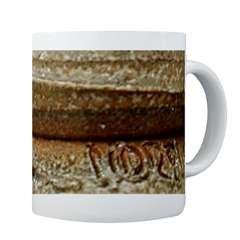
John Norris has come up with this hilarious idea. It's a standard, industrial produced mug with the imageof soda firing wrapped around it. It's the "perfect" soda mug.
I enjoy the cleverness of this, but it also helps remind me what I'm doing making handmade pots in a world of industrial pots. Making something that is beautiful in surface and form; designing a form that is not only visually pleasing, but ergonomic. And perhaps most importantly, making a human connection between the maker and the user.
I came upon this essay, "Potters, the Values of Craftsman, and Living True to Self" by Nathaniel Pearlman on his blog: Political Mammal, and I encourage you to read it. It puts into words another reason why potters make.

This is also a soda fired mug:

John Norris has come up with this hilarious idea. It's a standard, industrial produced mug with the imageof soda firing wrapped around it. It's the "perfect" soda mug.
I enjoy the cleverness of this, but it also helps remind me what I'm doing making handmade pots in a world of industrial pots. Making something that is beautiful in surface and form; designing a form that is not only visually pleasing, but ergonomic. And perhaps most importantly, making a human connection between the maker and the user.
I came upon this essay, "Potters, the Values of Craftsman, and Living True to Self" by Nathaniel Pearlman on his blog: Political Mammal, and I encourage you to read it. It puts into words another reason why potters make.
Workshop with Jordan Taylor
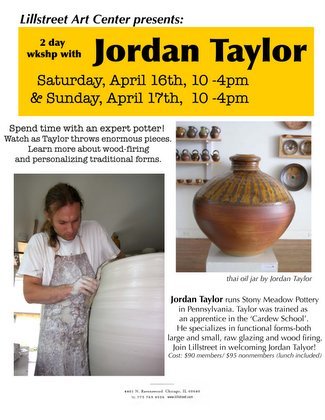
My good friend and fellow Earlham alum Jordan Taylor, is going to be coming to Lillstreet Art Center this April to do a 2 day workshop.
Jordan and I worked side by side on our senior projects at Earlham, making pots, loading and firing kilns. After we graduated, Jordan and I have both gone on to make pots full time- but we have arrived there by very different paths. Jordan went the route of many the clay graduate of EC, and did a long apprenticeship. He worked with Mark Skudlarek in Cambridge, Wisconsin for 3 1/2 years. After his apprenticeship was completed, he moved to north eastern Pennsylvania to set up his shop. He wrote an article for Ceramics Monthly about his journey of making pots.
In Union Dale, Pennsylvania Jordan built his wood kiln...
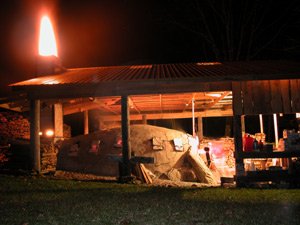
where he fires his pots...
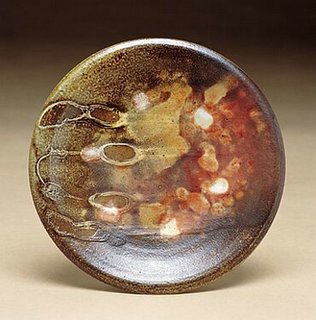
If you are interested in registering for this workshop, it's on April 16th and 17th -- contact Lillstreet Gallery for more information (773.769.4226).
500 Cups, Lark Books

500 Cups, cover, Lark Books
This February, Lark Books has released it's newest book is the "500" series. I am lucky enough to have two images in it.

page 110

page 351
My Lillstreet soda firing partner in crime, Gary Jackson,
also has an image in the book.

page 265
This series of books from Lark is beautifully done.
Inspirational for the potter and visually gratifying for the collector.
I also enjoy (and own) other book's from this series:



If you'd like to purchase the book
directly through Amazon...
Pottery Blog Mailing List and RSS feed
There are two main ways that you can subscribe to this blog.
or if you'd rather...
I've set up a mailing list so you can get an email anytime I make a posting to this blog. To subscribe to this mailing list, just fill out the box below with your email address and click "subscribe."
Please make sure when you're subscription type that you choose:
Email - send each message as it arrives.
If you do not choose this, all images and links will be stripped in the email.
Thanks for reading and subscribing!
or if you'd rather...
I've set up a mailing list so you can get an email anytime I make a posting to this blog. To subscribe to this mailing list, just fill out the box below with your email address and click "subscribe."
Please make sure when you're subscription type that you choose:
Email - send each message as it arrives.
If you do not choose this, all images and links will be stripped in the email.
Thanks for reading and subscribing!
| Subscribe to Pottery Blog |
| Email: |
| Visit this group |
Artist Statement
I recently wrote a new Artist Statement...
______________________________
I grew up in a small town in New Hampshire, surrounded by handmade things. Every Christmas my mom would go to the fabric store and buy all the different color corduroy that they had in stock to sew pants for us. The quilts on our beds and the curtains on the windows were made by her as well. Although my sister and I played with Barbies, the clothes were purchased at craft fairs, and my dad made beds for them that my mom finished off with hand sewn mattresses, pillows and quilts. My father is a painter. I've always been surrounded by his work, and observed him while he was inspired by the natural beauty of the New England landscape.
Things in our family were often handmade out of necessity. My mom baked all of our bread, in part, because it was less expensive. But it was also because she loved the process of making it. Growing up in an environment where so many things were made by hand that could have been more easily purchased, I learned to consider and appreciate the story behind a piece. The value comes from the care and thoughtfulness put in by the maker.
Coming from New Hampshire, it's easy to recognize the beauty of the environment. Six years ago I moved to Chicago, where the beauty of the environment is not as apparent. Beauty is still there, but it's in the more intimate aspects of life, not in majestic landscapes. I discovered that my inspiration came from the things that I encountered everyday; no longer a forest or a mountain, but those moments amid the busyness of the city where people slow down and appreciate their surroundings. I am honored when my pots can be a part of those moments in people's lives. Perhaps they will become as familiar to you as the patterns of the cracks in the ceiling above your bed.
Making pots is quiet and personal, an experience I want to be reflected in the pots themselves. But I also am a potter in a community of potters, working alongside both students and peers. Being a potter in a community, it is now hard to imagine myself as a solitary potter. Everyday I share resources, experience, and perspective with my fellow artists. As part of a large community I've been given many opportunities to teach students with diverse talents and backgrounds. Teaching has let me experiment with new ideas and perspectives, challenging myself at the same time as I challenge my students.
Being a potter is a very balanced profession. As a potter I am a designer, a maker, a business owner, a laborer a chemist, and a physicist. I love throwing, trimming, pulling handles, firing, I love to decorate, to sketch out ideas in the clay. I am lucky that given all the aspects of my profession, I love and enjoy them each, and I love the product of my craft and its place in the world and in people's lives.
______________________________
I grew up in a small town in New Hampshire, surrounded by handmade things. Every Christmas my mom would go to the fabric store and buy all the different color corduroy that they had in stock to sew pants for us. The quilts on our beds and the curtains on the windows were made by her as well. Although my sister and I played with Barbies, the clothes were purchased at craft fairs, and my dad made beds for them that my mom finished off with hand sewn mattresses, pillows and quilts. My father is a painter. I've always been surrounded by his work, and observed him while he was inspired by the natural beauty of the New England landscape.
Things in our family were often handmade out of necessity. My mom baked all of our bread, in part, because it was less expensive. But it was also because she loved the process of making it. Growing up in an environment where so many things were made by hand that could have been more easily purchased, I learned to consider and appreciate the story behind a piece. The value comes from the care and thoughtfulness put in by the maker.
Coming from New Hampshire, it's easy to recognize the beauty of the environment. Six years ago I moved to Chicago, where the beauty of the environment is not as apparent. Beauty is still there, but it's in the more intimate aspects of life, not in majestic landscapes. I discovered that my inspiration came from the things that I encountered everyday; no longer a forest or a mountain, but those moments amid the busyness of the city where people slow down and appreciate their surroundings. I am honored when my pots can be a part of those moments in people's lives. Perhaps they will become as familiar to you as the patterns of the cracks in the ceiling above your bed.
Making pots is quiet and personal, an experience I want to be reflected in the pots themselves. But I also am a potter in a community of potters, working alongside both students and peers. Being a potter in a community, it is now hard to imagine myself as a solitary potter. Everyday I share resources, experience, and perspective with my fellow artists. As part of a large community I've been given many opportunities to teach students with diverse talents and backgrounds. Teaching has let me experiment with new ideas and perspectives, challenging myself at the same time as I challenge my students.
Being a potter is a very balanced profession. As a potter I am a designer, a maker, a business owner, a laborer a chemist, and a physicist. I love throwing, trimming, pulling handles, firing, I love to decorate, to sketch out ideas in the clay. I am lucky that given all the aspects of my profession, I love and enjoy them each, and I love the product of my craft and its place in the world and in people's lives.
Studio Sale

This Friday December 3, from 5pm - 10pm is the opening night gala at my studio, Lillstreet Gallery, and all 26 artist studios at Lillstreet Studios in Chicago. We're located at 4401 N. Ravenswood Ave., in Chicago, IL. Come on up to my studio on the second floor (205 west).
My studio will be open during regular business hours throughout the first 3 weeks of December. Feel free to call or email ahead to make an appointment. Or just stop by... I'll be there.
I have lots of new work, like...

and...

and of course you can always find...

I will be taking credit cards, as well as checks and cash. Gift boxes are available.
If you can't make it to my studio, you can find work for sale on my website.
Or you can also find my work this season at:
- the Evanston Arts Center in Evanston, IL
- the Small Treasures Show at Lillstreet, in Chicago, IL
- the Illinois Artisan Shops, in Chicago, Springfield, and Whittington, IL
- Hannah Grimes Marketplace, in Keene, NH
- Cup: The Intimate Object III at the Charlie Cummings Clay Gallery, in Fort Wayne, IN
- Gallery 138 at Kent State University, in Kent, OH
Hope to see you soon...keep warm!
Correct or intended usage.
A couple of years ago I was at the Cambridge Pottery Festival in Cambridge, Wisconsin (outside of Madison) visiting my potter friend, Jordan Taylor, who was, at the time, apprenticing with Mark Skudlarek. The festival is an all clay art fair as well as the Pottery Olympics. I was in a bit of heaven for the weekend. I bought a couple of pots from different potters selling their wares. One of the pieces was a simple little temoku bowl with a triangulated rim and rutile brushstrokes on the interior. When I brought it up to the checkout area of the booth, the wife of the maker was tending the sales. Even though I had already decided on my purchase, she began to inform me of the bowl's many uses. "It's perfect for ice cream...just the right size for a snack of yogurt...measure out and set aside ingredients while cooking..." I didn't really say anything at the time - like "I think I can figure it out," but the whole idea of being told what a bowl was for seemed a little ridiculous. It's a moment that often comes back to me. I have probably used it for all it's suggested uses - but I could have figured them out all on my own. I don't blame her for offering up the list of suggestions, I often get the question "what's this for" when I sell my pots at a fair or out of my studio. To me, as a potter, it always seems obvious to me.  When I think it maybe not as obvious, I try to use a prop of some sort. Probably the most common pot that has it's function questioned are my wall vases.
When I think it maybe not as obvious, I try to use a prop of some sort. Probably the most common pot that has it's function questioned are my wall vases.
I try to display at least one of them with dried flowers in them, but I guess some people just have a hard time imagining it. Sometimes they want more of an answer of dried or fresh flowers, so I go into stories of people using them to hold real live plants, toothbrushes, or kitchen utensils (depending on the size) or how they're great for your deck (Chicagoans treasure their decks). But as a rule I don't offer up this information unless it's asked. I do understand that the more unusual objects might be a little bit hard to figure out - like the wall vases, oil lamps, butter dishes - but I often get asked the "what's it for" question for the most mundane pots like little sauce bowls, an oversized mug, or even a teapot. I happily answer the customer's questions, but I just wonder where people's imagination and logic have gone. I might think about a really specific use when I'm making things - like a shallow bowl-plate that is just perfect for a fresh salad - but I don't want to corner my pots into one specific use. I want people to take them home and discover new functions and incorporate them even further into their lives. It wouldn't have really occured to me to put kitchen utensils in a wall vase, but why not? I think it's a great idea.
We live in a cluttered world of things that all have a single purpose (and usually aren't that nice to look at). Think about all the small kitchen appliances that clutter our countertops: rice cookers, bread makers, vegetable steamers, waffle irons, pitzzelle makers. People seem to want to be told what to do. Along with the above mentioned appliances, hair dryers and other electric items all come with very important instruction manuals that tell us things like: "do not operate while in the bathtub or while asleep." I suppose it's a combination of our litigious society and, again, the lack of imagination and logic. I came upon this legal notice for the usage of mugs. I think it's pretty hillarious, but I hope that it never actually comes to this.
I suppose it's a combination of our litigious society and, again, the lack of imagination and logic. I came upon this legal notice for the usage of mugs. I think it's pretty hillarious, but I hope that it never actually comes to this.

I try to display at least one of them with dried flowers in them, but I guess some people just have a hard time imagining it. Sometimes they want more of an answer of dried or fresh flowers, so I go into stories of people using them to hold real live plants, toothbrushes, or kitchen utensils (depending on the size) or how they're great for your deck (Chicagoans treasure their decks). But as a rule I don't offer up this information unless it's asked. I do understand that the more unusual objects might be a little bit hard to figure out - like the wall vases, oil lamps, butter dishes - but I often get asked the "what's it for" question for the most mundane pots like little sauce bowls, an oversized mug, or even a teapot. I happily answer the customer's questions, but I just wonder where people's imagination and logic have gone. I might think about a really specific use when I'm making things - like a shallow bowl-plate that is just perfect for a fresh salad - but I don't want to corner my pots into one specific use. I want people to take them home and discover new functions and incorporate them even further into their lives. It wouldn't have really occured to me to put kitchen utensils in a wall vase, but why not? I think it's a great idea.
We live in a cluttered world of things that all have a single purpose (and usually aren't that nice to look at). Think about all the small kitchen appliances that clutter our countertops: rice cookers, bread makers, vegetable steamers, waffle irons, pitzzelle makers. People seem to want to be told what to do. Along with the above mentioned appliances, hair dryers and other electric items all come with very important instruction manuals that tell us things like: "do not operate while in the bathtub or while asleep."

Stacks of obsolete slides.
I have a love for functional objects...you might even say a soft spot. That's why I make pots. Pots are interactive pieces of art. Then you can get even extra "wow" out of a piece if it functions well on top of being aesthetically pleasing. A teapot that pours without dripping, or a mug that becomes one with the hand of the user, gives me deep satisfaction.
I like to see the potential function in all objects - even after they have ceased their original function. The other day I was walking down an alley (here in Chicago). I found this huge 5 foot octagonal window leaning against a dumpster. It was really lovely and was in perfect condition.
I stared at it for a while. "What could I use this for?" "How could I get this home in my hatchback?" "Where could I store it until I can use it?" "Is there someone I know that would just have to have it?" The answers to these questions were not very positive. So I made a little deal with myself and left it up to fate. I went into a store (for about 20min.), and decided that if it was there when I came back, then I would figure out a way to take it. But if it was gone... then perhaps it was just not meant to be. It was gone.
This brings me to my stacks of obsolete slides. I think every working artist must have one. A potter's stack might be a bit bigger since we probably make more pots than a painter makes paintings. (Not that I actually document all my pieces.)
Anyway.. my stacks consist of: compositions that didn't work out; extra brackets; old dupes that will never be sent into any sort of show; incorrect exposures; the accidental roll of outdoor film that was used instead of the indoor film; first and very poor attempts to take my own slides on wrinkled sheets; booth shots from an old set-up. All images that have no more use. But the time, effort and money that went into all these makes it impossible for me to ever dispose of them. It's nice that they're small because I can store them guilt-free. But now I don't think that I need to store them anymore. There is a perfect use for them thanks to one of my favorite magazines, Ready Made.

I think this lamp idea is great. Can you imagine how nicely the thick plastic mounts will hang?
So for now, I will hang on to my stack of obsolete slides. Someday I will get around to this project and give my slides a chance at a second function.
I like to see the potential function in all objects - even after they have ceased their original function. The other day I was walking down an alley (here in Chicago). I found this huge 5 foot octagonal window leaning against a dumpster. It was really lovely and was in perfect condition.
I stared at it for a while. "What could I use this for?" "How could I get this home in my hatchback?" "Where could I store it until I can use it?" "Is there someone I know that would just have to have it?" The answers to these questions were not very positive. So I made a little deal with myself and left it up to fate. I went into a store (for about 20min.), and decided that if it was there when I came back, then I would figure out a way to take it. But if it was gone... then perhaps it was just not meant to be. It was gone.
This brings me to my stacks of obsolete slides. I think every working artist must have one. A potter's stack might be a bit bigger since we probably make more pots than a painter makes paintings. (Not that I actually document all my pieces.)
Anyway.. my stacks consist of: compositions that didn't work out; extra brackets; old dupes that will never be sent into any sort of show; incorrect exposures; the accidental roll of outdoor film that was used instead of the indoor film; first and very poor attempts to take my own slides on wrinkled sheets; booth shots from an old set-up. All images that have no more use. But the time, effort and money that went into all these makes it impossible for me to ever dispose of them. It's nice that they're small because I can store them guilt-free. But now I don't think that I need to store them anymore. There is a perfect use for them thanks to one of my favorite magazines, Ready Made.

I think this lamp idea is great. Can you imagine how nicely the thick plastic mounts will hang?
So for now, I will hang on to my stack of obsolete slides. Someday I will get around to this project and give my slides a chance at a second function.
Useful coffee stains
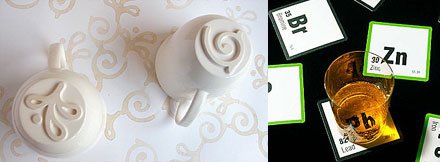
Stamp Cups
As someone who is trying to make it in the world as a potter, I try to make nice pots and be confident that that will sell them. Sometimes I try to figure out some sort of clever quirk that might push someone over the edge to actually buy a piece- a nice detail that shows that I paid attention - something to show that it was handmade. This stamp cup idea is definitely not an innovation that I have thought about before, and I don't actually think that I would make something with this idea.... but at least I can appreciate the cleverness.
